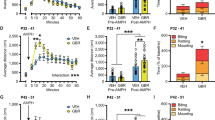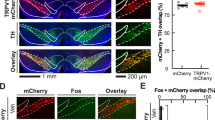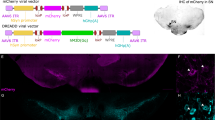Abstract
A decrease in dopamine D2 receptor (D2R) binding in the striatum is one of the most common findings in disorders that involve a dysregulation of motivation, including obesity, addiction and attention deficit hyperactivity disorder. As disruption of D2R signaling in the ventral striatum—including the nucleus accumbens (NAc)—impairs motivation, we sought to determine whether potentiating postsynaptic D2R-dependent signaling in the NAc would improve motivation. In this study, we used a viral vector strategy to overexpress postsynaptic D2Rs in either the NAc or the dorsal striatum. We investigated the effects of D2R overexpression on instrumental learning, willingness to work, use of reward value representations and modulation of motivation by reward associated cues. Overexpression of postsynaptic D2R in the NAc selectively increased motivation without altering consummatory behavior, the representation of the value of the reinforcer, or the capacity to use reward associated cues in flexible ways. In contrast, D2R overexpression in the dorsal striatum did not alter performance on any of the tasks. Thus, consistent with numerous studies showing that reduced D2R signaling impairs motivated behavior, our data show that postsynaptic D2R overexpression in the NAc specifically increases an animal’s willingness to expend effort to obtain a goal. Taken together, these results provide insight into the potential impact of future therapeutic strategies that enhance D2R signaling in the NAc.
This is a preview of subscription content, access via your institution
Access options
Subscribe to this journal
Receive 12 print issues and online access
$259.00 per year
only $21.58 per issue
Buy this article
- Purchase on Springer Link
- Instant access to full article PDF
Prices may be subject to local taxes which are calculated during checkout





Similar content being viewed by others
References
Koob GF . Hedonic valence, dopamine and motivation. Mol Psychiatry 1996; 1: 186–189.
Wise RA . Dopamine and reward: the anhedonia hypothesis 30 years on. Neurotox Res 2008; 14: 169–183.
Schultz W . Behavioral theories and the neurophysiology of reward. Annu Rev Psychol 2006; 57: 87–115.
Wang GJ, Volkow ND, Thanos PK, Fowler JS . Imaging of brain dopamine pathways: implications for understanding obesity. J Addict Med 2009; 3: 8–18.
Volkow ND, Wang GJ, Fowler JS, Tomasi D, Telang F . Addiction: beyond dopamine reward circuitry. Proc Natl Acad Sci USA 2011; 108: 15037–15042.
Volkow ND, Wang GJ, Newcorn JH, Kollins SH, Wigal TL, Telang F et al. Motivation deficit in ADHD is associated with dysfunction of the dopamine reward pathway. Mol Psychiatry 2011; 16: 1147–1154.
Gjedde A, Kumakura Y, Cumming P, Linnet J, Moller A . Inverted-U-shaped correlation between dopamine receptor availability in striatum and sensation seeking. Proc Natl Acad Sci USA 2010; 107: 3870–3875.
Huang CL, Yang YK, Chu CL, Lee IH, Yeh TL, Chen PS et al. The association between the Lie scale of the Maudsley personality inventory and striatal dopamine D2/D3 receptor availability of healthy Chinese community subjects. Eur Psychiatry 2006; 21: 62–65.
Tomer R, Goldstein RZ, Wang GJ, Wong C, Volkow ND . Incentive motivation is associated with striatal dopamine asymmetry. Biol Psychol 2008; 77: 98–101.
Salamone JD, Correa M . The mysterious motivational functions of mesolimbic dopamine. Neuron 2012; 76: 470–485.
Salamone JD, Correa M, Farrar A, Mingote SM . Effort-related functions of nucleus accumbens dopamine and associated forebrain circuits. Psychopharmacology (Berl) 2007; 191: 461–482.
Flagel SB, Clark JJ, Robinson TE, Mayo L, Czuj A, Willuhn I et al. A selective role for dopamine in stimulus-reward learning. Nature 2011; 469: 53–57.
Berridge KC . The debate over dopamine’s role in reward: the case for incentive salience. Psychopharmacology (Berl) 2007; 191: 391–431.
Tran AH, Tamura R, Uwano T, Kobayashi T, Katsuki M, Matsumoto G et al. Altered accumbens neural response to prediction of reward associated with place in dopamine D2 receptor knockout mice. Proc Natl Acad Sci USA 2002; 99: 8986–8991.
Cardinal RN, Pennicott DR, Sugathapala CL, Robbins TW, Everitt BJ . Impulsive choice induced in rats by lesions of the nucleus accumbens core. Science 2001; 292: 2499–2501.
Hauber W, Sommer S . Prefrontostriatal circuitry regulates effort-related decision making. Cereb Cortex 2009; 19: 2240–2247.
Trifilieff P, Rives ML, Urizar E, Piskorowski RA, Vishwasrao HD, Castrillon J et al. Detection of antigen interactions ex vivo by proximity ligation assay: endogenous dopamine D2-adenosine A2A receptor complexes in the striatum. Biotechniques 2011; 51: 111–118.
Han Y, Moreira IS, Urizar E, Weinstein H, Javitch JA . Allosteric communication between protomers of dopamine class A GPCR dimers modulates activation. Nat Chem Biol 2009; 5: 688–695.
Jung MY, Skryabin BV, Arai M, Abbondanzo S, Fu D, Brosius J et al. Potentiation of the D2 mutant motor phenotype in mice lacking dopamine D2 and D3 receptors. Neuroscience 1999; 91: 911–924.
Simpson EH, Kellendonk C, Ward RD, Richards V, Lipatova O, Fairhurst S et al. Pharmacologic rescue of motivational deficit in an animal model of the negative symptoms of schizophrenia. Biol Psychiatry 2011; 69: 928–935.
Ward RD, Simpson EH, Richards VL, Deo G, Taylor K, Glendinning JI et al. Dissociation of hedonic reaction to reward and incentive motivation in an animal model of the negative symptoms of schizophrenia. Neuropsychopharmacology 2012; 37: 1699–1707.
Holmes NM, Marchand AR, Coutureau E . Pavlovian to instrumental transfer: a neurobehavioural perspective. Neurosci Biobehav Rev 2010; 34: 1277–1295.
Pickel VM, Garzon M, Mengual E . Electron microscopic immunolabeling of transporters and receptors identifies transmitter-specific functional sites envisioned in Cajal's neuron. Prog Brain Res 2002; 136: 145–155.
Drew MR, Simpson EH, Kellendonk C, Herzberg WG, Lipatova O, Fairhurst S et al. Transient overexpression of striatal D2 receptors impairs operant motivation and interval timing. J Neurosci 2007; 27: 7731–7739.
Ward RD, Simpson EH, Richards VL, Deo G, Taylor K, Glendinning JI et al. Dissociation of hedonic reaction to reward and incentive motivation in an animal model of the negative symptoms of schizophrenia. Neuropsychopharmacology 2012; 37: 1699–1707.
Zanich ML, Fowler H . Transfer from Pavlovian appetitive to instrumental appetitive conditioning: signaling versus discrepancy interpretations. J Exp Psychol Anim Behav Process 1978; 4: 37–49.
Balleine BW, Ostlund SB . Still at the choice-point: action selection and initiation in instrumental conditioning. Ann N Y Acad Sci 2007; 1104: 147–171.
Stelzel C, Basten U, Montag C, Reuter M, Fiebach CJ . Frontostriatal involvement in task switching depends on genetic differences in d2 receptor density. J Neurosci 2010; 30: 14205–14212.
Volkow ND, Wang GJ, Fowler JS, Thanos PP, Logan J, Gatley SJ et al. Brain DA D2 receptors predict reinforcing effects of stimulants in humans: replication study. Synapse 2002; 46: 79–82.
Sonuga-Barke EJ, Fairchild G . Neuroeconomics of attention-deficit/hyperactivity disorder: differential influences of medial, dorsal, and ventral prefrontal brain networks on suboptimal decision making? Biol Psychiatry 2012; 72: 126–133.
Monterosso J, Piray P, Luo S . Neuroeconomics and the study of addiction. Biol Psychiatry 2012; 72: 107–112.
Rowland NE, Vaughan CH, Mathes CM, Mitra A . Feeding behavior, obesity, and neuroeconomics. Physiol Behav 2008; 93: 97–109.
Martinez D, Broft A, Foltin RW, Slifstein M, Hwang DR, Huang Y et al. Cocaine dependence and d2 receptor availability in the functional subdivisions of the striatum: relationship with cocaine-seeking behavior. Neuropsychopharmacology 2004; 29: 1190–1202.
Nikolaus S, Antke C, Beu M, Muller HW . Cortical GABA, striatal dopamine and midbrain serotonin as the key players in compulsive and anxiety disorders—results from in vivo imaging studies. Rev Neurosci 2010; 21: 119–139.
Volkow ND, Wang GJ, Telang F, Fowler JS, Thanos PK, Logan J et al. Low dopamine striatal D2 receptors are associated with prefrontal metabolism in obese subjects: possible contributing factors. NeuroImage 2008; 42: 1537–1543.
Martinez D, Carpenter KM, Liu F, Slifstein M, Broft A, Friedman AC et al. Imaging dopamine transmission in cocaine dependence: link between neurochemistry and response to treatment. Am J Psychiatry 2011; 168: 634–641.
Mott AM, Nunes EJ, Collins LE, Port RG, Sink KS, Hockemeyer J et al. The adenosine A2A antagonist MSX-3 reverses the effects of the dopamine antagonist haloperidol on effort-related decision making in a T-maze cost/benefit procedure. Psychopharmacology (Berl) 2009; 204: 103–112.
Nowend KL, Arizzi M, Carlson BB, Salamone JD . D1 or D2 antagonism in nucleus accumbens core or dorsomedial shell suppresses lever pressing for food but leads to compensatory increases in chow consumption. Pharmacol Biochem Behav 2001; 69: 373–382.
Pardo M, Lopez-Cruz L, Valverde O, Ledent C, Baqi Y, Muller CE et al. Adenosine A2A receptor antagonism and genetic deletion attenuate the effects of dopamine D2 antagonism on effort-based decision making in mice. Neuropharmacology 2012; 62: 2068–2077.
Pereira M, Farrar AM, Hockemeyer J, Muller CE, Salamone JD, Morrell JI . Effect of the adenosine A2A receptor antagonist MSX-3 on motivational disruptions of maternal behavior induced by dopamine antagonism in the early postpartum rat. Psychopharmacology (Berl) 2011; 213: 69–79.
Sink KS, Vemuri VK, Olszewska T, Makriyannis A, Salamone JD . Cannabinoid CB1 antagonists and dopamine antagonists produce different effects on a task involving response allocation and effort-related choice in food-seeking behavior. Psychopharmacology (Berl) 2008; 196: 565–574.
Treadway MT, Buckholtz JW, Cowan RL, Woodward ND, Li R, Ansari MS et al. Dopaminergic mechanisms of individual differences in human effort-based decision-making. J Neurosci 2012; 32: 6170–6176.
Zhang M, Balmadrid C, Kelley AE . Nucleus accumbens opioid, GABaergic, and dopaminergic modulation of palatable food motivation: contrasting effects revealed by a progressive ratio study in the rat. Behav Neurosci 2003; 117: 202–211.
Wirtshafter D, Stratford TR . Evidence for motivational effects elicited by activation of GABA-A or dopamine receptors in the nucleus accumbens shell. Pharmacol Biochem Behav 2010; 96: 342–346.
Kelley AE, Delfs JM . Dopamine and conditioned reinforcement. I. Differential effects of amphetamine microinjections into striatal subregions. Psychopharmacology (Berl) 1991; 103: 187–196.
Cagniard B, Balsam PD, Brunner D, Zhuang X . Mice with chronically elevated dopamine exhibit enhanced motivation, but not learning, for a food reward. Neuropsychopharmacology 2006; 31: 1362–1370.
Bello EP, Mateo Y, Gelman DM, Noain D, Shin JH, Low MJ et al. Cocaine supersensitivity and enhanced motivation for reward in mice lacking dopamine D2 autoreceptors. Nat Neurosci 2011; 14: 1033–1038.
Yin HH, Zhuang X, Balleine BW . Instrumental learning in hyperdopaminergic mice. Neurobiol Learn Mem 2006; 85: 283–288.
Pecina S, Cagniard B, Berridge KC, Aldridge JW, Zhuang X . Hyperdopaminergic mutant mice have higher ‘wanting’ but not ‘liking’ for sweet rewards. J Neurosci 2003; 23: 9395–9402.
Iversen SD, Iversen LL . Dopamine: 50 years in perspective. Trends Neurosci 2007; 30: 188–193.
Robbins TW, Roberts DC, Koob GF . Effects of d-amphetamine and apomorphine upon operant behavior and schedule-induced licking in rats with 6-hydroxydopamine-induced lesions of the nucleus accumbens. J Pharmacol Exp Ther 1983; 224: 662–673.
Cador M, Robbins TW, Everitt BJ . Involvement of the amygdala in stimulus-reward associations: interaction with the ventral striatum. Neuroscience 1989; 30: 77–86.
Amalric M, Koob GF . Functionally selective neurochemical afferents and efferents of the mesocorticolimbic and nigrostriatal dopamine system. Prog Brain Res 1993; 99: 209–226.
Belin D, Jonkman S, Dickinson A, Robbins TW, Everitt BJ . Parallel and interactive learning processes within the basal ganglia: relevance for the understanding of addiction. Behav Brain Res 2009; 199: 89–102.
Reynolds JN, Wickens JR . Dopamine-dependent plasticity of corticostriatal synapses. Neural Netw 2002; 15: 507–521.
Palmiter RD . Dopamine signaling in the dorsal striatum is essential for motivated behaviors: lessons from dopamine-deficient mice. Ann N Y Acad Sci 2008; 1129: 35–46.
Balleine BW, Liljeholm M, Ostlund SB . The integrative function of the basal ganglia in instrumental conditioning. Behav Brain Res 2009; 199: 43–52.
Darvas M, Palmiter RD . Restricting dopaminergic signaling to either dorsolateral or medial striatum facilitates cognition. J Neurosci 2010; 30: 1158–1165.
Kellendonk C, Simpson EH, Polan HJ, Malleret G, Vronskaya S, Winiger V et al. Transient and selective overexpression of dopamine D2 receptors in the striatum causes persistent abnormalities in prefrontal cortex functioning. Neuron 2006; 49: 603–615.
Gerfen CR, Surmeier DJ . Modulation of striatal projection systems by dopamine. Annu Rev Neurosci 2011; 34: 441–466.
Perreault ML, Hasbi A, O'Dowd BF, George SR . The dopamine d1-d2 receptor heteromer in striatal medium spiny neurons: evidence for a third distinct neuronal pathway in basal ganglia. Front Neuroanat 2011; 5: 31.
Alcantara AA, Chen V, Herring BE, Mendenhall JM, Berlanga ML . Localization of dopamine D2 receptors on cholinergic interneurons of the dorsal striatum and nucleus accumbens of the rat. Brain Res 2003; 986: 22–29.
Apicella P, Ravel S, Deffains M, Legallet E . The role of striatal tonically active neurons in reward prediction error signaling during instrumental task performance. J Neurosci 2011; 31: 1507–1515.
Mottola DM, Kilts JD, Lewis MM, Connery HS, Walker QD, Jones SR et al. Functional selectivity of dopamine receptor agonists. I. Selective activation of postsynaptic dopamine D2 receptors linked to adenylate cyclase. J Pharmacol Exp Ther 2002; 301: 1166–1178.
Morgenstern PF, Marongiu R, Musatov SA, Kaplitt MG . Adeno-associated viral gene delivery in neurodegenerative disease. Methods Mol Biol 2011; 793: 443–455.
Acknowledgements
We thank Claudia Schmauss for the generous gift of D2R KO mice and Christoph Kellendonk for discussion and comments on the manuscript. This work was supported, in part, by US National Institutes of Health Grants DA022413, MH054137 (to JAJ), MH068073 (to PDB), MH068073 (to PDB), MH086404 (to JAJ, HM, EHS), by The Sidney R Baer Jr Foundation (to HM), by a Research Associate Award from the Research Foundation for Mental Hygiene (to PT), an EMBO Long-Term fellowship and the Basque Country Government (to EU), National Institute of Mental Health Grant F32MH090750-01 (to RDW) and by the Lieber Center for Schizophrenia Research and Treatment. PT, JAJ, EHS, PDB and HM designed research; PT, BF, EU and VW performed research; PT, RDW, KMT, PDB and HM analyzed the data; and PT, EHS, PDB, HM, DM and JAJ wrote the paper. All the authors participated in interpreting the data and edited the manuscript.
Author information
Authors and Affiliations
Corresponding author
Ethics declarations
Competing interests
The authors declare no conflict of interest.
Additional information
Supplementary Information accompanies the paper on the Molecular Psychiatry website
Supplementary information
Rights and permissions
About this article
Cite this article
Trifilieff, P., Feng, B., Urizar, E. et al. Increasing dopamine D2 receptor expression in the adult nucleus accumbens enhances motivation. Mol Psychiatry 18, 1025–1033 (2013). https://doi.org/10.1038/mp.2013.57
Received:
Revised:
Accepted:
Published:
Issue Date:
DOI: https://doi.org/10.1038/mp.2013.57
Keywords
This article is cited by
-
Disentangling the role of NAc D1 and D2 cells in hedonic eating
Molecular Psychiatry (2023)
-
Short-active gestational photoperiod reduces effortful choice behavior in mice, partial normalization by d-amphetamine
Psychopharmacology (2023)
-
How changes in dopamine D2 receptor levels alter striatal circuit function and motivation
Molecular Psychiatry (2022)
-
Increased elasticity of sucrose demand during hyperdopaminergic states in rats
Psychopharmacology (2022)
-
Dose-response effects of d-amphetamine on effort-based decision-making and reinforcement learning
Neuropsychopharmacology (2021)



